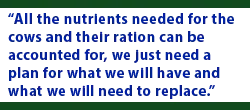
What’s the goal? More milk or reduced purchased feed costs?
 By Dr. Owen Mickley, Vita Plus dairy specialist
By Dr. Owen Mickley, Vita Plus dairy specialist
You’ve likely been told “variety A will produce more milk than variety B” when choosing your forage crop varieties.
However, it usually doesn’t work exactly that way in the real world.
Purchasing decisions
As the growing season and harvest wrap up, it’s time to take inventory of your current forage situation and consider what path will be the best route to profitability next year.
We first evaluate the quality and quantity of this year’s crop and try to make sense of the impacts of weather, variety selection, and agronomy practices on our forage programs. Next, we consider what purchased feeds are needed to best augment available forages. Discount opportunities for early “lock it in” commitments on inputs are worth evaluating, and these order deadlines seem to creep up earlier in the fall every year.
Prices have eased some, but we are still above our target contracting prices on many commodities. We expect to hear many “produce more milk” pitches, but the ultimate goal continues to be to produce as much milk as possible while keeping feed costs in check. Strong forage inventories are a good start in our hedge against purchased feed costs. As we plan forward, we aren’t necessarily looking for a magical variety that gives us an additional 5 pounds of milk. We are looking to hold production – and perhaps improve milk components – while lowering feed costs.
 Think protein and digestible fiber
Think protein and digestible fiber
Purchased protein for our dairy rations receives a lot scrutiny. Forages like alfalfa provide our main hedge against these costs, but – compared to corn silage – cover crops and other alternative forages can further reduce our needs for purchased protein.
In addition, these forages and other cool-season grasses have less indigestible NDF and a larger pool of potentially digestible NDF. Corn silage and alfalfa are the king and queen of forges, but inclusion of grasses in the lactating diet increases the portion of digestible NDF and can allow for greater feed efficiency potential. These forages also may help us save some feed dollars if byproducts with high NDF digestibility remain expensive. Sorghum-sudangrass will not limit intake like other grasses, and it too has a wide range in potentially digestible NDF content. If corn silage varieties with a higher digestible NDF pool were added the silage inventory this fall, it may result in further feed cost savings.
One of the difficulties we’ve always faced in dairy farming is that so many factors impact our feeding plans and, thus, feed costs. Inventories, feed contracts, and logistics are some of the significant factors we must accommodate. Understanding and carefully selecting forage varieties, aiming for forages with higher digestible nutrient pools, and taking the steps to harvest and store crops at the highest possible quality are key in lowering feed costs and efficiently producing milk.
This article was written for the Hoard’s Dairyman Guest Blog. Click here for the original article.
About the author: Dr. Owen Mickley is a dairy specialist based in eastern Ohio. He earned his bachelor’s degree in animal sciences and his doctor of veterinary medicine degree from The Ohio State University. Prior to joining Vita Plus, Mickley served as a practicing veterinarian in New York and Ohio for three years. He worked closely with clients to achieve production objectives, monitor progress and construct a sustainable operational model. Today, he works closely with dairy producers and his fellow Vita Plus technical staff teammates to bring a comprehensive team approach to the farms in his area.
| Category: |
Business and economics Crop varieties Dairy Performance Feed quality and nutrition Forage harvesting Milk production and components Silages |

